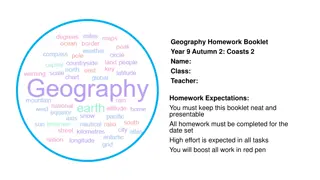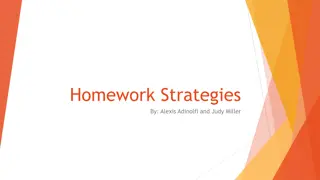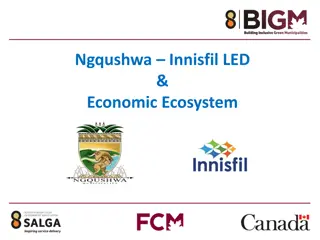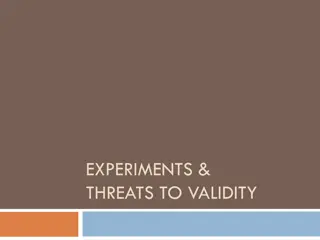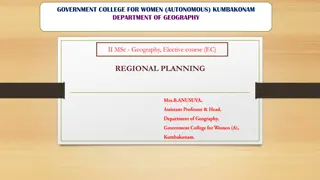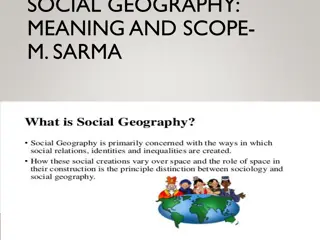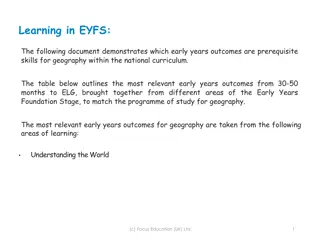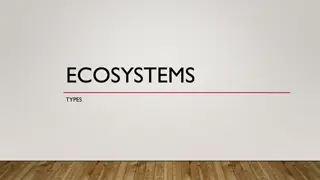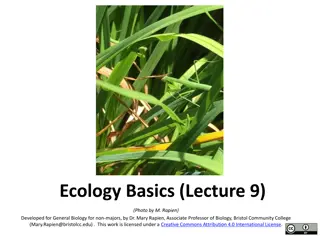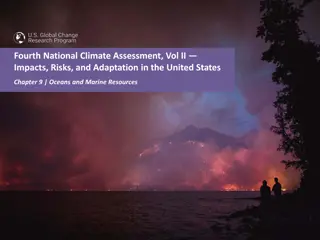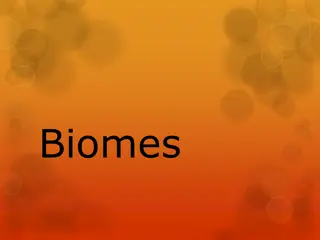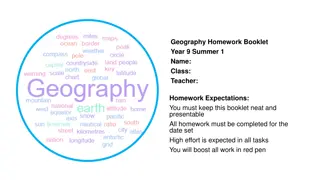Geography Homework: Threats to Ecosystems Recap
Explore the weekly homework tasks focused on ecosystems, covering topics such as ecosystem functions, food chains, adaptations, and deforestation. From studying climate graphs to identifying key terms and definitions, this booklet aims to enhance understanding of environmental challenges. Dive into the world of ecosystems through engaging exercises and insightful questions.
Download Presentation

Please find below an Image/Link to download the presentation.
The content on the website is provided AS IS for your information and personal use only. It may not be sold, licensed, or shared on other websites without obtaining consent from the author. Download presentation by click this link. If you encounter any issues during the download, it is possible that the publisher has removed the file from their server.
E N D
Presentation Transcript
Geography Homework Booklet Threats to Ecosystems Name: Class: Teacher: Homework Expectations: You must keep this booklet neat and presentable All homework must be completed for the date set High effort is expected in all tasks You will boost all work in red pen
Weekly Homework Ecosystems 1.1 Ecosystems Function Recap Knowledge Book P133, P137 1. Study the Penang Climate graph on P53 - Draw the missing data onto the graph below: 3. Fill in the key terms and definitions for the following, using P50: Key Term Definition Ecosystem Climate A climate of hot temperatures and rainfall for only half the year. A climate of hot and humid conditions all year round. 2. Use P53. Answer these questions about Penang s climate: Photosynthesis a) Identify the wettest month. ___________________________________________ Adjust/ or to change. b) How low is the lowest temperature? ___________________________________ c) Which month(s) have the hottest temperature? ___________________________ Stakeholder d) TRUE or FALSE: There are no dry months in Penang? ____________________ Xerophytic e) Which is the driest month in Penang? __________________________________ f) Approx. How much rainfall, falls in August? ___________________________ Evaporation from leaves, trees, and vegetation. g) What is the average temperature in Penang? _____________________________
Weekly Homework Ecosystems 1.2 Food Chains and Adaptations Recap Knowledge Book P133, 139, 147 1. Use P133 to find a key term/ definition to complete the table. Then use P147 to provide an example from the Semi-arid Grassland to complete the food chain in the final column. Key Term Definition 3. Use P133 to find a key term/ definition to complete the table. Key Term Definition Example Producer Leaves that have fallen to the ground and are decomposing. Acacia Tree Primary Consumer Biomass Secondary Consumer Decomposers Eat primary and secondary consumers as their main source of food. They are the top of the food chain. When a plant or animal adjusts or changes to suit its environment. 2. Use P139, describe the following plant adaptations and draw a picture: 4. Use P146. Around the Acacia tree, label all the different adaptations: Adaptation Description of Adaptation Drawing of Adaptation Drip Tip Leaves Buttress Roots Lianas
Weekly Homework Ecosystems 1.3 Deforestation Knowledge Book P154-P156 3. Use P68 in your KB. Explain the causes of deforestation [6 marks] 1a. What is deforestation? ____________________________________________________________________________ Deforestation is _____________________________________________________________ ____________________________________________________________________________ ___________________________________________________________________________. 1b. Draw an icon/ image to help you remember what deforestation is: One cause of deforestation is __________________________________________________. This is where trees are cut down to _____________________________________________ ____________________________________________________________________________ ____________________________________________________________________________ ____________________________________________________________________________ ____________________________________________________________________________ Another cause of deforestation is ______________________________________________. 2. Read the local and global effects of deforestation below. Decide whether they are social, environmental, or economic effects. Here, tree s are removed because ______________________________________________ ____________________________________________________________________________ a) Millions of species have died and become extinct. ________________________________ ____________________________________________________________________________ b) Less CO2 is being absorbed from the atmosphere. _______________________________ ____________________________________________________________________________ c) Indigenous people have been forced to relocate. _________________________________ ____________________________________________________________________________ d) Deforestation can consume a country s only natural resource meaning they may one day A third reason for deforestation is ______________________________________________. have nothing to trade on the global market. ____________________________________ Trees are cut down due to _____________________________________________________ e) Biodiversity in the tropical rainforest is decreasing. _______________________________ ____________________________________________________________________________ f) Potential cures to human diseases are being lost. ________________________________ ____________________________________________________________________________ g) Less trees means the soil becomes loose and more likely to wash away, leading to ____________________________________________________________________________ desertification. ____________________________________________________________ ____________________________________________________________________________ h) Large quantities of CO2 are being re-released when trees are felled. _________________ i) Whole tribes have been lost to western diseases e.g. Malaria._______________________
Weekly Homework Ecosystems 1.4 Map Skills: Scale, Distance, Compass Points and Grid References Interpreting Scale: N a) 2cm on the map is what distance in real life? _______________________________ b) 3cm on the map is what distance in real life? _______________________________ c) 0.5km in real life is how many cm on the map? ____________________________ d) 4.5km in real life is how many cm on the map? ____________________________ Measuring Distance: a) On the map, how many cm apart are and ? _____________________ b) On the map, how many cm apart are and ? _____________________ c) In real life, how far apart in km are and ? _______________________ d) In real life, how far apart in km are and ? _______________________ Compass Points (Identify the correct compass direction): a) To get from to you travel ___________________________________ b) To get from to you travel ___________________________________ c) To get from to you travel ___________________________________ d) To get from to you travel ___________________________________ 6- Figure Grid References: a) What is the 6 figure grid reference for the ? ____________________________ b) Which shape is found in grid reference 225,468? ____________________________ 2cm 2cm: 1km c) Draw a in grid reference 236,453 1km
Weekly Homework Ecosystems 1.5 Sustainable Management of Tropical Rainforests Knowledge Book P157-158 1a. Define the following key terms: 3. Use P71 in your KB. Explain how the tropical rainforest can be sustainably managed [6] Sustainable management is ___________________________________________________ Sustainable- _________________________________________________________________ ___________________________________________________________________________. ____________________________________________________________________________ One way the rainforest can be sustainably manages is creating national parks. This is when ____________________________________________________________________________ ____________________________________________________________________________ ____________________________________________________________________________ Ecotourism- _________________________________________________________________ ____________________________________________________________________________ ____________________________________________________________________________ This is sustainable because ____________________________________________________ 1b. Come up with your own definition of management : ____________________________________________________________________________ ____________________________________________________________________________ Management- ________________________________________________________________ However, one problem with this strategy is _______________________________________ ____________________________________________________________________________ ____________________________________________________________________________ ____________________________________________________________________________ ____________________________________________________________________________ Another management strategy is ______________________________________________. 3. Study P72. Answer the following questions about the case study Costa Rica: This involves _______________________________________________________________ a) In which continent is Costa Rica located? _______________________________________ ____________________________________________________________________________ b) With which country do they have a debt for nature swap with? ____________________ ____________________________________________________________________________ An advantage of this strategy is ________________________________________________ c) How much of the land is classified as protected in Costa Rica? ______________________ ____________________________________________________________________________ d) What are countries looking to create throughout the whole of Central America? _______ ____________________________________________________________________________ ___________________________________________________________________________ However, an issue with this strategy is ___________________________________________ ____________________________________________________________________________ e) By the year ________. How much will Costa Rica earn from ecotourism? ______________
Weekly Homework Ecosystems 1.6 Coastal Landforms Knowledge Book: P68-76 3. Draw a diagram, then explain the formation of wave-cut platform: 1. Fill in the key terms and definitions for the following: Key Term Definition Hydraulic Action Naturally occurring material that is broken down by processes of weathering and erosion. Abrasion Lagoon 2. Which landform is being described? _____________________________________________ _____________________________________________ _____________________________________________ _____________________________________________ _____________________________________________ _____________________________________________ _____________________________________________ _____________________________________________ _____________________________________________ _____________________________________________ _____________________________________________ a) This landform joins together two headlands. __________________________________ b) Alternating bands of hard rock and soft rock. __________________________________ c) Hydraulic action creates a wave-cut notch in the cliff. ___________________________ d) Form where the coast suddenly changes direction. _____________________________ e) Sub-aerial processes attack the top of the archway. _____________________________ f) Strong winds curve the end of this landform. __________________________________ g) A real-world example is Old Harry Rocks . _____________________________________ h) This landform causes the cliff to retreat overtime. ______________________________ i) A lagoon forms behind this landform. ________________________________________
Threats and Management of Semi-Arid Grasslands Weekly Homework Ecosystems 1.7 Knowledge Book P160 3. Use P73 in your KB. Explain how semi-arid grasslands can be sustainably managed [6] 3. Use P73 to complete the table about threats to semi-arid grasslands. Create an icon to help you remember the threat. One way semi-arid grasslands can be managed is by ______________________________ This is where ______________________________________________________________ The Threat Description of Threat Icon/ Diagram __________________________________________________________________________ It sustainably manages the ecosystem because ___________________________________ Fires __________________________________________________________________________ __________________________________________________________________________ __________________________________________________________________________ Another management strategy is _____________________________________________ Monoculture This involves ______________________________________________________________ __________________________________________________________________________ It is sustainable because... ____________________________________________________ __________________________________________________________________________ Tourism __________________________________________________________________________ __________________________________________________________________________ A third sustainable management strategy is _____________________________________ Hunting & Poaching This is when ______________________________________________________________ __________________________________________________________________________ It s a sustainable technique because ___________________________________________ __________________________________________________________________________ Urbanisation __________________________________________________________________________ __________________________________________________________________________
Weekly Homework Ecosystems 1.8 Small Scale Ecosystem: Attenborough Nature Reserve Knowledge Book P149 1. Use P64. Read the information about Attenborough and answer the questions: 3. Use the table on P64. Identify the opinions and conflicts of different stakeholders: a) How many miles is Attenborough Nature Reserve from Nottingham? _________________ Stakeholder Why they like Attenborough Nature Reserve Which stakeholder do they conflict with and why? b) Which river creates the moving water ecosystem? ________________________________ Attracts a wide variety of birds = good for bird watching Provides a protected breeding ground for rare species Teachers because the visitor centre/ classroom ruins the natural feel of the area Joggers because they may scare off the wildlife c) What type of consumer is a frog? ______________________________________________ Wildlife Trust Member d) In geography, someone with a vested interest is called a ___________________________ e) Before it was a nature reserve, Attenborough was a _____________________________ f) Identify two stakeholder. ____________________________________________________ g) Why do people visit Attenborough Nature Reserve? _______________________________ Teacher 2. Use P64 to draw out and label a food chain found in Attenborough Nature Reserve: Birch Tree ____________ ____________ ____________ ____________ Attenborough Resident ____________ ____________ ____________ ____________ Producer ____________ ____________ ____________ ____________ Jogger
Questions to ask: ___________________________ ___________________________ ___________________________ ___________________________ ___________________________ ___________________________ ___________________________ ___________________________ ___________________________ ___________________________ ___________________________ ___________________________ ___________________________ ___________________________ ___________________________ ___________________________ ___________________________ Notes: ___________________________ ___________________________ ___________________________ ___________________________ ___________________________ ___________________________ ___________________________ ___________________________ ___________________________ ___________________________ ___________________________ ___________________________ ___________________________ ___________________________ ___________________________ ___________________________ ___________________________
Questions to ask: ___________________________ ___________________________ ___________________________ ___________________________ ___________________________ ___________________________ ___________________________ ___________________________ ___________________________ ___________________________ ___________________________ ___________________________ ___________________________ ___________________________ ___________________________ ___________________________ ___________________________ Notes: ___________________________ ___________________________ ___________________________ ___________________________ ___________________________ ___________________________ ___________________________ ___________________________ ___________________________ ___________________________ ___________________________ ___________________________ ___________________________ ___________________________ ___________________________ ___________________________ ___________________________
Questions to ask: ___________________________ ___________________________ ___________________________ ___________________________ ___________________________ ___________________________ ___________________________ ___________________________ ___________________________ ___________________________ ___________________________ ___________________________ ___________________________ ___________________________ ___________________________ ___________________________ ___________________________ Notes: ___________________________ ___________________________ ___________________________ ___________________________ ___________________________ ___________________________ ___________________________ ___________________________ ___________________________ ___________________________ ___________________________ ___________________________ ___________________________ ___________________________ ___________________________ ___________________________ ___________________________
Questions to ask: ___________________________ ___________________________ ___________________________ ___________________________ ___________________________ ___________________________ ___________________________ ___________________________ ___________________________ ___________________________ ___________________________ ___________________________ ___________________________ ___________________________ ___________________________ ___________________________ ___________________________ Notes: ___________________________ ___________________________ ___________________________ ___________________________ ___________________________ ___________________________ ___________________________ ___________________________ ___________________________ ___________________________ ___________________________ ___________________________ ___________________________ ___________________________ ___________________________ ___________________________ ___________________________





